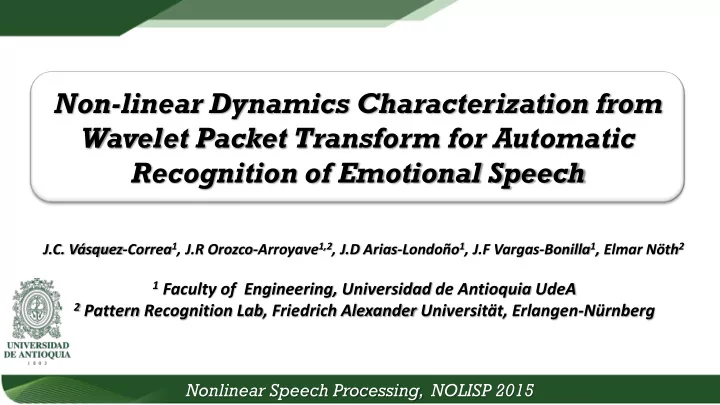

Non-linear Dynamics Characterization from Wavelet Packet Transform for Automatic Recognition of Emotional Speech J.C. Vásquez-Correa 1 , J.R Orozco-Arroyave 1,2 , J.D Arias-Londoño 1 , J.F Vargas-Bonilla 1 , Elmar Nöth 2 1 Faculty of Engineering, Universidad de Antioquia UdeA 2 Pattern Recognition Lab, Friedrich Alexander Universität, Erlangen-Nürnberg Nonlinear Speech Processing, NOLISP 2015
Outline 1. Introduction 2. Methodology 3. Databases 4. Results 5. Conclusion NOLISP-2015 jcamilo.vasquez@udea.edu.co 2
1. Introduction Recognition of emotion in speech: Call centers Emergency services Psychologic therapy Intelligent vehicles Video games NOLISP-2015 jcamilo.vasquez@udea.edu.co 3
1. Introduction Disgust Fear • The interest has been focused on detection of fear-type Fear-type emotions which appear in emotions situations where the human integrity is at risk. Anger Desperation NOLISP-2015 jcamilo.vasquez@udea.edu.co 4
1. Introduction Low frequency High frecuency Lv0 • WPT provides a time-frequency Lv1 multi-resolution analysis. NLD measures are estimated in each Lv2 decomposed band. Lv3 Wavelet Packet Transform (WPT) NOLISP-2015 jcamilo.vasquez@udea.edu.co 5
Outline 1. Introduction 2. Methodology 3. Databases 4. Results 5. Conclusion NOLISP-2015 jcamilo.vasquez@udea.edu.co 6
2. Methodology GMM- CD, LLE, WPT UBM HE, LZC Voiced Voiced/Unvoiced Decision Emotion segmentation Speech signal logE, GMM- logE_TEO, WPT UBM LLE, SE Unvoiced NOLISP-2015 jcamilo.vasquez@udea.edu.co 7
2. Methodology Segmentation Two types of sound: Voiced Unvoiced Both kind of segments are processed independently NOLISP-2015 jcamilo.vasquez@udea.edu.co 8
2. Methodology Wavelet Packet Transform Low frequency High frecuency Features are estimated on each band: Lv0 Log-Energy Lv1 Teager Energy Operator (TEO) Lv2 Entropies (Shannon, log-Energy) NLD (CD, LLE, HE, LZC) Lv3 Wavelet Packet Transform (WPT) NOLISP-2015 jcamilo.vasquez@udea.edu.co 9
2. Methodology GMM-UBM GMM emotion 1 GMM Universal MAP emotion 2 Background Adaptation Model (UBM) ⋮ GMM emotion k NOLISP-2015 jcamilo.vasquez@udea.edu.co 10
2. Methodology 0.6 0.4 0.2 0 -0.2 -0.4 -0.6 -0.8 0 2 4 6 8 10 12 x 10 4 0.4 0.3 0.2 1764 samples 50% 0.1 0 overlapping -0.1 -0.2 -0.3 -0.4 0 500 1000 1500 𝑜 Feature estimation 𝑀𝑀 𝑌, Θ = log(𝑄 𝑌, Θ 𝑙 ) 𝑙=1 clasification ⋯ P(X,Θ) 𝑙 P(X,Θ) 𝑙+1 P(X,Θ) 𝑜 NOLISP-2015 jcamilo.vasquez@udea.edu.co jcamilo.vasquez@udea.edu.co 11
2. Methodology Final Decision Two different GMM were created for classification task, which are based on: 1. Voiced segments 2. Unvoiced segments Then are combined in a second classification stage according to P(Score fusion)= *P(GMM Voiced)+(1- )*P(GMM Unvoiced) NOLISP-2015 jcamilo.vasquez@udea.edu.co jcamilo.vasquez@udea.edu.co 12
Outline 1. Introduction 2. Methodology 3. Databases 4. Results 5. Conclusion NOLISP-2015 jcamilo.vasquez@udea.edu.co 13
3. Databases Database Num Num Sample Emotions recordings speakers frequency recognized GVEESS 224 12 44100 Anger Disgust Fear Desperation Berlin 534 10 16000 Anger Disgust Fear eNTERFACE05 1317 44 44100 Anger Disgust Fear NOLISP-2015 jcamilo.vasquez@udea.edu.co 14
Outline 1. Introduction 2. Methodology 3. Databases 4. Results 5. Conclusion NOLISP-2015 jcamilo.vasquez@udea.edu.co 15
3. Results Voiced Segments Features GVEESS Berlin eNTERFACE Accuracy Accuracy Accuracy DC 57.1±14.6 62.7±13.9 47.6±3.8 LLE 68.0±16.2 67.6±8.1 52.1±4.9 HE 68.1±28.0 67.6±8.1 52.0±4.9 LZC 82.0±11.3 78.3±9.9 54.0±7.3 Comb 65.0±21.2 79.0±10.0 51.1±8.0 NOLISP-2015 jcamilo.vasquez@udea.edu.co 16
3. Results Unvoiced Segments Features GVEESS Berlin eNTERFACE Accuracy Accuracy Accuracy LogEnergy 93.4±9.8 64.7±11.1 46.9±4.4 LogEnergy TEO 93.1±8.8 60.8±8.1 54.2±4.9 SE 93.4±9.8 71.0±12.7 53.7±5.8 LEE 92.3±10.3 77.2±10.9 57.0±4.1 Comb. 99.0±2.5 69.1±16.0 63.1±15.7 NOLISP-2015 jcamilo.vasquez@udea.edu.co 17
3. Results Combination of probabilities LZC Voiced and Comb. Unvoiced NOLISP-2015 jcamilo.vasquez@udea.edu.co 18
Outline 1. Introduction 2. Methodology 3. Databases 4. Results 5. Conclusion NOLISP-2015 jcamilo.vasquez@udea.edu.co 19
4. Conclusion 1. A new set of features based on NLD measures calculated from WPT are extracted from speech signals to perform the automatic recognition of fear-type emotions. The voiced and unvoiced segments of each recording are characterized separately. 2. The results indicate that LZC evaluated from wavelet decomposition in voiced segments provides a good representation of emotional speech. 3. Features derived from energy and entropy calculated from unvoiced segments are suitable to characterize emotional speech. NOLISP-2015 jcamilo.vasquez@udea.edu.co 20
4. Conclusion 4. The evaluation of proposed features could be used as complement of classical features for emotion recognition from speech. 5. The proposed features must be evaluated in speech recordings in non-controlled noise conditions, and the wavelet transform in superior levels of decomposition must be addressed in future work in order to consider more resolution in frequency domain. NOLISP-2015 jcamilo.vasquez@udea.edu.co 21
Thanks! NOLISP-2015 jcamilo.vasquez@udea.edu.co 22
Recommend
More recommend